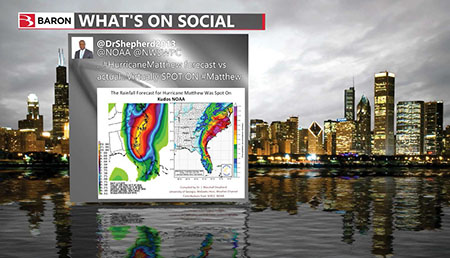Keeping Up With the Weather ‘Mets’
OTTAWA—TV meteorologists operate around the clock, continually creating content for the 24/7 real-time weather cycle on multiple platforms. In doing so, these ‘Mets’ (as they call themselves) have to rapidly sort through viewer-submitted photos and videos on social media, with an eye to grabbing and distributing the very best footage before anyone else.
That’s just the start: Factor in advances such as augmented reality where real-time graphics are overlaid on broadcast video (such as The Weather Channel “creating” a tornado in its studio); 2D/360 images where the Met can rotate the viewer inside a single camera view; and the detailed experimental content being streamed online from NOAA’s GOES-16 satellite (which is still in test mode), and today’s TV meteorologists are busier than ever before. By the way, most don’t have the budget to hire extra staff to help them cope.

Like most weather graphics packages, Baron’s Lynx is tightly integrated with social media.
THE METS’ WISH LIST
Not surprisingly, vendors of weather graphics platforms such as AccuWeather, Baron, ChyronHego, The Weather Company (formerly WSI; now owned by IBM), and Vizrt are doing their best to provision all of these new options. The Weather Company has even integrated IBM’s Watson augmented intelligence platform (the super computer that won TV’s “Jeopardy” against two human contestants) into its presentation products, to speed up content processing while reducing the human workload.
Yet this is still not enough for bleeding-edge Mets such as Brad Panovich, chief meteorologist at WCNC-TV, the NBC affiliate in Charlotte, N.C.
“The time it takes for presentation software to ingest and process viewer social media videos for air is their biggest downside,” said Panovich. “It doesn’t work efficiently in real-time—especially for 1080p—and it really lapses during extreme weather situations. So I use an HDMI convertor to bring my laptop into our presentation system as a video feed, and access submitted content from my Twitter ‘TweetDeck’ and my Facebook page.”
Panovich makes his “hack” work by plugging his laptop in at WCNC’s video wall and changing the feeds directly while he’s live on air. “It’s just basically throwing my laptop’s screen up on air, in real-time,” he said.
Get the TV Tech Newsletter
The professional video industry's #1 source for news, trends and product and tech information. Sign up below.
Eric Sorensen, senior meteorologist at WQAD-TV, the ABC affiliate in Moline/The Qaud Cities, Ill., is another forward-thinking Met who wishes weather presentation technology could do everything he wants it to do. Specifically, “today’s technology is great for pushing content out to our viewers on social media, but we really need these systems to turn social media into a two-way street,” he said. “What we need is to be able to know, from every viewer that’s out there, what’s happening in that storm. I really hope that the weather presentation vendors, whose products continue to progress, find a way to bring that viewer feedback into our broadcasts in real-time—without us having to do it ourselves.”

Eric Sorensen
SOCIAL MEDIA PUSH
As dedicated Mets, Panovich and Sorensen are demanding as much as they can from modern technology to serve their viewers better while besting their competition at the same time. In response, vendors are doing their best to meet these needs in a variety of ways.
At AccuWeather, for instance, “our new StormDirector+ and StoryTeller has the ability to search social media by keywords and hashtags,” said Bill Boss, director of product development for the State College, Pa.-based company. “This gives our customers a quick way to search for trending photos and videos in real-time and instantly get them on the air making viewers’ real-time feedback and submissions part of the story.”
Meanwhile, Baron’s Lynx graphics and storm tracking package focuses on providing customizable forecasting tools that make their Mets “the experts that viewers trust and can count on,” said Mike Mougey, vice president of sales for the Huntsville, Ala.-based company. “We believe very strongly that providing context and content in an easily accessible format will set stations apart on the local level.”
ChyronHego’s Metacast weather graphics suite accelerates the ingest of viewer-generated content for air by connecting Metacast to a broadcast client’s social media platforms. This connection, plus “the ability to include uploaded content as media files within a broadcaster’s weather graphics production system, are key elements of advanced, real-time weather presentation,” said Karl Eggestad, sales director for ChyronHego Metacast.
With its use of IBM’s Watson augmented intelligence, The Weather Company has been able to incorporate machine-based curation into its Max Engage with Watson platform. “Your meteorological staff first ‘tells’ Watson what hyper local weather elements your viewers care about and then the system locates and provides them on your weather platform automatically,” said Rodney Thompson, systems and software operations leader for the Atlanta-based company.
Vizrt’s multiplatform suite of weather graphics work seamlessly with all forms of viewer-generated content, according to James Monroe, manager of weather sales for Vizrt Americas. “We work with all forms of social media and any online sources broadcasters choose,” he said. “Our Viz platform lets you designate reliable viewers as ‘Trusted Suppliers,’ so their high value content go directly into your graphics system for immediate playout, making you first to air.”
With virtual reality on the horizon, the push for TV weather packages that provide quicker, better and more impressive graphics will only gather momentum. “For instance, I can easily imagine producing VR weather video for viewers to access online in real-time, tailored to their specific markets,” said Michael Potts, vice president of design for The Weather Channel. “Anything that TV meteorologists can do to make the weather more real and more informative to our audiences, we will do.”
James Careless is an award-winning journalist who has written for TV Technology since the 1990s. He has covered HDTV from the days of the six competing HDTV formats that led to the 1993 Grand Alliance, and onwards through ATSC 3.0 and OTT. He also writes for Radio World, along with other publications in aerospace, defense, public safety, streaming media, plus the amusement park industry for something different.

